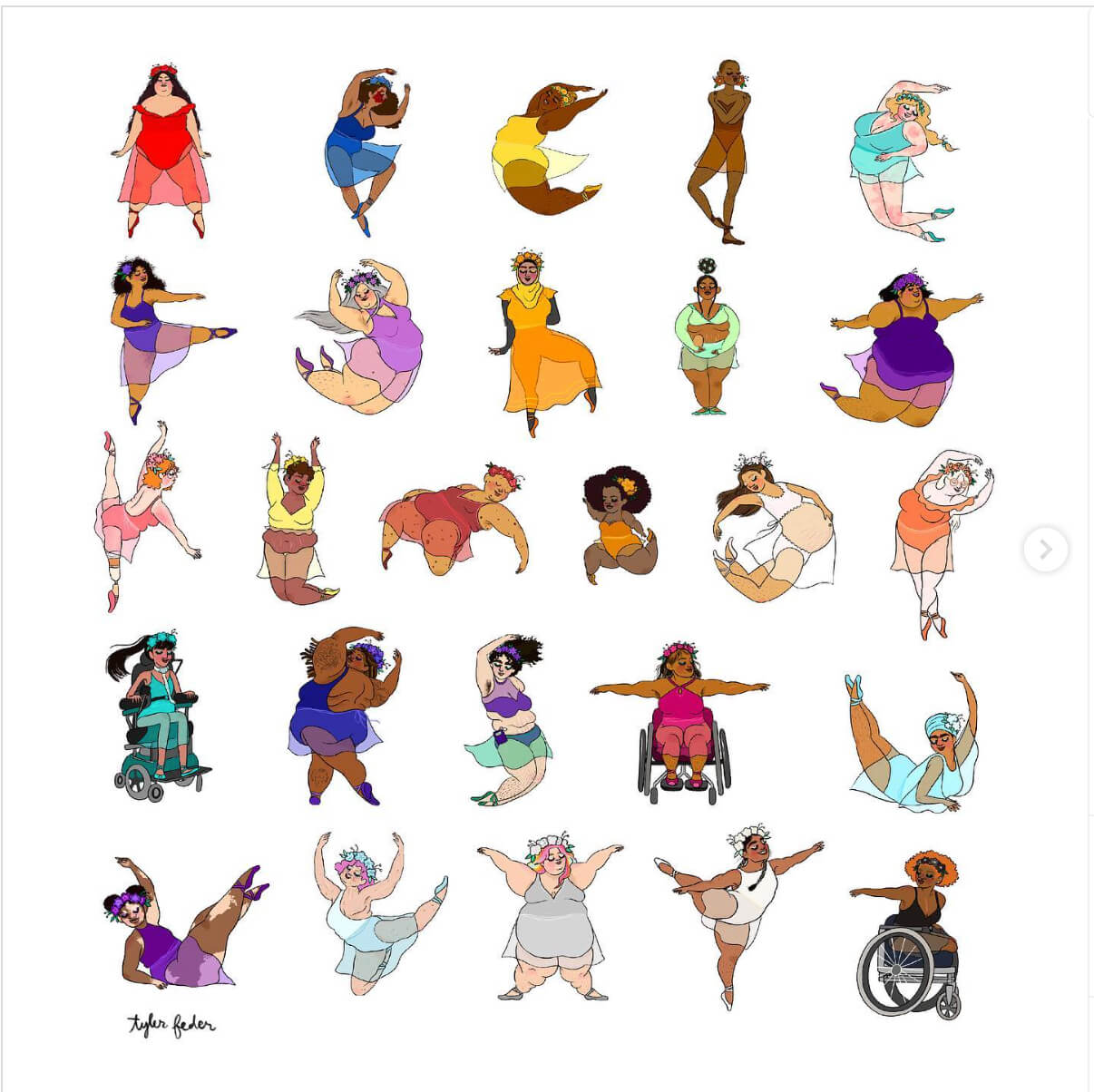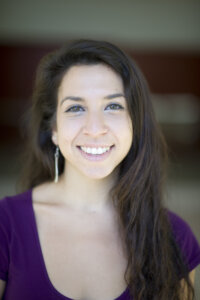A is for apron belly, B is for birthmark: How one Jewish artist celebrates all kinds of bodies
Tyler Feder wants to normalize a more accurate depiction of society as it truly is, rather than focusing on one small slice of it

Graphic by Angelie Zaslavsky
There’s a story Tyler Feder says she’s told in countless interviews, but she’s going to tell it again anyway. It’s a good thing, too, because it captures something essential about why she does what she does — and why so many friends and strangers respond to her work.
In the mid ’90s, when Feder was a little kid, she was hanging out in the basement at home in Buffalo Grove, Illinois, while her dad did his morning workout routine. It wasn’t one of the many popular tapes of that era, she said, but his own self-designed set of exercises. He would do “these,” she said, demonstrating arm circles over Zoom, and sit-ups and such. And he said something about wanting rocklike abs.
“I remember just being scandalized,” Feder said. “Like, wouldn’t everyone want to be soft?” She couldn’t comprehend it, especially because she and her sisters liked to rest their heads on his midsection as though it were a pillow.
“The giant boulder of diet culture fell on me so soon after that. But to remember that there was this moment where I genuinely couldn’t understand why he would want to have a different body than what he had,” she said. “What if all kids just stayed that way? And they just kept thinking that bodies are just bodies, you don’t have to aggressively change them. Wouldn’t that be so great?”
Today, Feder is a Chicago-based artist who tries to help kids hold on to that notion — and adults to recapture it. One of her most recent projects to that end was a drawing challenge on Instagram that celebrated physical features from A to Z.
Bodies — of all kinds — are cool
A few years ago, when Feder was preparing to write and illustrate her picture book, Bodies Are Cool, aimed at preschoolers, she put out a call on social media: What’s a body part or physical feature people wished they’d learned to love as kids?
“I got so many comments, way more than anything I’ve ever posted,” said Feder, speaking quietly from her desk at home, her dark hair and bright red glasses immediately recognizable from some of her self-portraits. She compiled the answers into a list. “My hair’s too curly, my hair’s too straight, my hair’s thinning, my hair’s too thick … and that’s just in the hair section,” she said, ticking off some examples.
When she created the vibrant, colorful spreads for Bodies Are Cool — lots of people celebrating a birthday or building sandcastles at the beach — she tried to incorporate as many of the features as she could. She weaves them into other drawings too, sometimes at the request of one of her many social media followers — she has more than 72,000 on Instagram alone — who might ask, for example, “Can you show someone with a C-section scar?”
As Feder considered this past fall what she’d do for her annual drawing challenge — she’s tackled one every October since 2017 — she decided to home in on these physical features. This time, her challenge would be “Bodtober”: She’d post 26 drawings on Instagram throughout the month, highlighting and celebrating a physical feature for every letter of the alphabet. A is for “apron belly,” B is for “birthmark,” C is for “cellulite,” and so forth, though Feder snuck in extra features to extend how many she could represent and speak to the fact that we’re all more than just one defining characteristic.

Feder set two other parameters for herself: Each of the drawings would be a ballerina posed in the shape of the letter they were representing. It was a nostalgic choice, a beloved drawing subject dating back to kindergarten, around the time she started taking dance classes. “Ballet was always my favorite, and I really love the aesthetic — I love all the swishy, sheer fabrics and the skirts and the way they wear their hair,” she said. Plus, “ballet has such a strict body type that’s usually associated with it so that was an extra bonus of being able to expand what we think of when we picture a ballerina.”
And with each letter, she’d lean into her grapheme-color synesthesia — a phenomenon where people’s perception of letters and numbers becomes associated with particular colors. “I don’t know really how it started or where the colors came from. But it helps me remember things,” Feder said, like addresses she can visualize as a series of colors. For this challenge, she let her synesthesia determine the hue of the corresponding ballerina’s outfit. E, for eczema, wore “robin’s egg-ish blue-green,” for example, and H, for hip dips, wore “butterscotch orange.”
If you scroll through Feder’s alphabet, one other thing that stands out right away is the sense of joy. The drawings are bright and cheerful. The characters wear serene expressions and little smiles as they leap, stretch, or pose.
“These are just people like everyone else and they deserve to experience joy and be portrayed joyfully,” Feder said. But so often they aren’t. Early on after she stumbled into the world of body positivity through other “liberal social justice things” she was into, Feder followed a blog called Shapely Prose. One concept that came up periodically was “the headless fatty,” like in the dehumanizing, neck-down b-roll that often appeared in news reports about the obesity epidemic. And then there were the weight loss ads and the sitcom fat jokes and so very few, if any, nuanced and positive representations of anyone who isn’t white, thin, non-disabled and conventionally attractive.
As Feder puts it, “Why shouldn’t people that don’t fit this one norm get to be depicted and romanticized in a joyful way?”
S is for stretch marks — and super Jewish?
When Feder drew the letter S for stretch marks on Monday, Oct. 24, she wrote in her caption: “I’ve been feeling really overwhelmed by the antisemitism in the news this week so I made this ballerina look kind of related to me and my big Ashkenazi Jewish family.”
Feder grew up in what she calls a “super Jewish family.” They were Conservative — not politically, she’s quick to clarify — and lived in an area with many other Jewish families, always attending bar and bat mitzvahs. “My parents and grandparents always talked about antisemitism,” she said. For a long time, she just didn’t see it in her own life.
But as she and her art have become more visible online — and drawings on themes of body positivity in particular get negative responses in addition to thankful ones — she’s been on the receiving end of antisemitic messages, “which is completely new to me and it’s jarring.” All the antisemitism in the news wears on her too, but it also makes her want to dig her heels in. “I feel like the more antisemitism I hear about, it makes me more and more into being Jewish,” she said.
By the time we met on Zoom in March, she couldn’t remember precisely what it was she’d been reacting to that day in late October. “I think that was when one of the Kanye West antisemitism things was happening,” she said. Perhaps it was the demonstrators who stood behind banners that read, “Kanye is right about the Jews,” and, “Honk if you know,” on a Los Angeles freeway overpass that weekend, extending their arms forward in Nazi salutes.
“When I’m drawing all these diverse people, I tend to focus on groups that don’t look like me. Obviously, I’m white and have a lot of white privilege. But there are still people that think I’m evil or want my family and culture dead because I’m Jewish,” Feder said. So on that day, when the news was heavy with antisemitism, she responded with a drawing that felt personal. “There’s no one way for a Jewish person to look, but there’s the way that my Jewish family looks — thick, dark, poofy hair and chubbiness,” she said. Putting her family on the page, she added, was “a way of comforting myself.”
Drawings for change
As Feder drew her way through the alphabet, her followers saw themselves in various letters and found comfort and joy in them as well.
“I can’t tell you how much it means to me to have my body depicted like this,” someone commented on A for apron belly. “I’ve sometimes lacked self-compassion with eczema,” another wrote a few days later. “She reminds me that I’m actually doing just fine. ?” The drawings garnered thousands of likes and repeated calls to turn the series into a book or a poster. The latter is now available on Feder’s Etsy shop, along with coloring pages and other items.
Like so many of her followers, Feder knows what it’s like to grapple with “body stuff,” as she called it. “I grew up hating my body. And feeling like my body was wrong. And there was only one good way that a body can look,” Feder said. “I was a skinny kid. I was pretty lanky and I would get praised for it. So I thought it was something good about me,” she added. “Then I went through puberty and gained weight and I thought, ‘Oh my god what’s wrong with me?’” It didn’t help that when she was growing up, the kitchen was stocked with diet foods and the whole family went to Weight Watchers together when Feder was in eighth grade.
Much of Feder’s work today is about making all kinds of bodies and people more visible and normalizing a more accurate depiction of society as it truly is, rather than focusing on one small slice of it. “The more we get used to seeing people represented in a positive way, the less shocking it is, and the more we just incorporate it into the way that we look at the world.”
For her first two October drawing challenges, she recreated famous paintings and stills from movies, respectively, but made them more diverse. Think of a Black Mona Lisa with natural hair, The Kiss as an intimate moment between an interracial queer couple, or Elle Woods commanding the courtroom from a wheelchair. These days, “if I am drawing people and they all look the same, it feels weird.”
Feder writes and draws about mental health, too. It’s all connected, she said. Her 2020 book, Dancing at the Pity Party, subtitled “a dead mom graphic memoir,” starts before her mother’s ovarian cancer diagnosis and continues after her death when Feder was a sophomore in college, reflecting on the grief of a “motherless life” with candor and humor. Her next book, Are You Mad at Me? — cowritten with one of her sisters and set to be published in September — is a picture book that follows an anxious ostrich who always thinks other animals are mad at her.
“I want to make change in the way that I can,” Feder said. “And the thing that I can do is make art and create visibility.” If she can make work that helps people see both themselves and others in a more generous way, then her job here is done. Not that she’s planning to stop anytime soon.
















